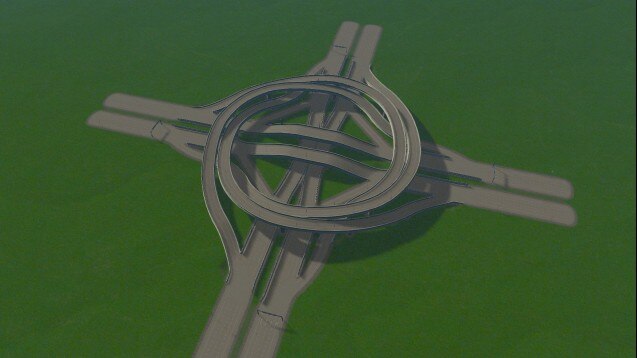Interchanges with lane mathematics
This is a collection of interchanges built for good functionality with Cities Skylines traffic AI by implementing ‘Lane Mathematics’. This ensures easy merging and splitting of traffic within these interchanges and less backups of traffic.
Also taken into consideration are the nodes in the roads of the interchanges. Nodes are displayed as circles on the road and provide an opportunity for the traffic AI to let traffic change lanes. Having too many or few, or some too close to each other can negatively influence your traffic flow (it leads to unnecessary weaving of traffic, cars being forced into lanes they don’t want to go, or cars ignoring traffic lights for example). The amount of nodes is therefore reduced to a minimum, keeping in mind the nodes that are needed for lane-changing (like in the Cloverleaf Interchange where changing lanes is necessary). As well as the distance between them.
This makes the traffic flow of these interchanges a lot smoother.
To achieve this, and in the creation of these interchanges, I’ve made use of the following mods:
– Fine Roal Tool
– Fine Road Anarchy
– Move it!
– Node Controller
– Node Spacer
– Precision Engineering
– Parallel Road Tool
You do NOT need to subscribe to any of the above mods to enjoy these interchanges! I do recommend useing TM:PE in combination with these interchanges (in particular the service interchanges) to get the best traffic flow!!
(Note: I’m also creating a collection of these interchanges useing North American roads. Interested? See: https://steamcommunity.com/sharedfiles/filedetails/?id=2483669010 )
Because ‘3-lane highways’ are the most commonly used highway type on maps, I’ve created these interchanges to be connected (the highway ends in each interchange) to these 3-lane highways.
All these Interchanges come without any beautfication like trees, props or retaining walls. Any markings on the roads are part of the roads themself. This way you don’t have to subscribe to a lot of extra assets, and you can add your own touch to these interchanges. I did make sure no streetlights are clipping through elevated roads and that there’s more than enough space for traffic to move between levels. I also made sure all the roads smoothly transition into each other.
I don’t use Network Extension 2. All roads used are Vanilla roads (some from the Mass Transit DLC) and roads I got from the Workshop (mostly Vanilla+ roads by Delta 5-1). I therefore recommend looking at the interchanges describtion page to see if, and if so, what other road-assets might be needed from the workshop.
Quick guide to interchanges:
There are basically two types of interchanges. ‘Service Interchanges’ and ‘System Interchanges’.
* System interchanges:
System interchanges are highway-to-highway connections. This mainly comes in the form of two crossing highways connecting with eachother (4-directional), or when a new highway starts from an existing one (3-directional). System interchanges are also called ‘free-flow interchanges’ meaning all traffic can move uninterrupted to each different direction. i.e. no traffic lights or intersections.
The system interchanges in this collection are:
– 3-Directional Y-Interchane (3-dir)
– Half-Clover Interchange (3-dir)
– T-Interchange (3-dir)
– Trumpet Interchange (3-dir)
– Y-Interchange (3-dir)
– 2-Level Cloverstack Interchange (4-dir)
– 3-Level Cloverstack Interchange (4-dir)
– Cloverleaf Interchange (4-dir)
– Diverging Windmill Interchange (4-dir)
– Double Trumpet Interchange (4-dir)
– Double Y-Interchange (4 dir)
– Full Diamond Interchange (4-dir)
– Hybrid Cloverstack Interchange (4-dir)
– Stack Interchange (4-dir)
– Turbine Interchange (4-dir) / (The Spiral Ring Interchange in this collection is a more compact version of a Turbine interchange)
– U-turn Interchange (4-dir)
– Windmill Interchange (4-dir)
– Semi Directional Diverging Turbine Interchange (6-dir)
The following system interchanges connect two parallel highways.
– Dual Half-Clover Interchange (4-dir)
– Dual Y-Interchange
– Extended Paperclip Interchange (4-dir)
– Paperclip Interchange (2-dir)
* Service Interchanges:
These interchanges connect a highway to a regular road network. They’re the best way to connect your city roads to a highway. However, chosing the right one for the job can be tricky. Unlike system interchanges, most of these interchanges are not free-flow interchanges. This means there usually is one or more intersections with traffic lights present. That said, these type of interchanges are designed to reduce the number of steps these traffic lights have. The traffic lights of a DDI and ParClo A4 for instance, only have two steps, while the SPUI has one traffic light with three steps.
Because these interchanges are placed near, or even within your city, the space around them is very valuable. The different types of service interchanges therefore have very different designs, leaving valuable building space on specific sides of these interchanges (the different ParClo interchanges are a good example of this. The number in their names tells you in how many corners/quadrants of the interchanges on-, and off-ramps are present)
The service interchanges in this collection are (if not present, they will be shortly!):
– Cloverleaf Service Interchange (free-flow)
– Diamond Interchange
– Diverging Diamond Interchange (DDI)
– Dogbone Interchange
– Dumbbell Interchange
– Milwaukee A
– Milwaukee B
– Partial Cloverleaf Interchange (Parclo A2)
– Partial Cloverleaf Interchange (Parclo A4)
– Partial Cloverleaf Interchange (Parclo B2)
– Partial Cloverleaf Interchange (Parclo B4)
– Partial Cloverleaf Interchange (Parclo AB2)
– Partial Cloverleaf Interchange (Parclo AB4)
– Single Point Urban Interchange (SPUI)
– Single Point Urban Partial Cloverleaf Interchange (SPUPClo)
Keep in mind that interchanges are BIG! Even the smallest interchange takes up a lot of space!!
If there is an interchange design that you think is missing from this collection, then let me know. I’ll create one.
Any comments, suggestions and/or feedback is much appreciated! And if you like this collection so much that you think others should see it as well, then please rate it!
Want to know how ‘Lane mathemetics’ work and how to use the functions of TM:PE? I recommend watching some of Biffa’s traffic fixing video’s at https://www.youtube.com/playlist?list=PLR5G_Kc9r-JDza2Bzd2GIA01_jVyHhhXw.



